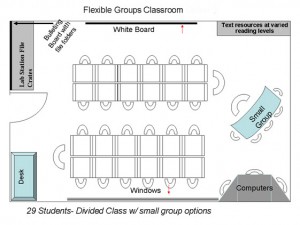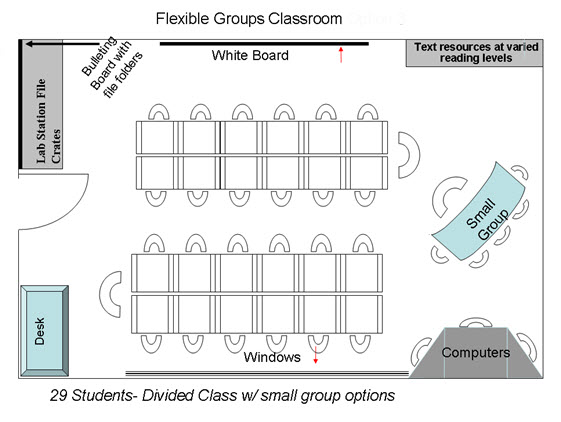A Class Divided in Half
 One day, while coaching at a middle school in North Carolina, I entered a small classroom, found that the teachers had divided the class in half, and were doing alternative teaching. They had arranged the desks in a conference table style. The two teachers were at either end so as not to drown each other out. Because it was like a conference table with the students so close together and the teacher right there, they had complete behavioral control. It was one of the most effective uses of small space I’ve ever seen.
One day, while coaching at a middle school in North Carolina, I entered a small classroom, found that the teachers had divided the class in half, and were doing alternative teaching. They had arranged the desks in a conference table style. The two teachers were at either end so as not to drown each other out. Because it was like a conference table with the students so close together and the teacher right there, they had complete behavioral control. It was one of the most effective uses of small space I’ve ever seen.
The Flexible Grouping Strategy Unveiled
Decide on a physical classroom desk and table arrangement for differentiating learning among groups:
- Will a one-room arrangement work or will you need to have options for multiple arrangements depending on the group activity required?
- How will the class be rearranged when necessary? What will be required to accomplish rearranging the classroom?
- What routines and skills are necessary for students to learn to have the class run smoothly when we deviate from the traditional row arrangement? Have students practice moving from one room arrangement to another.
- Use a signal, either a hand gesture or a sound, to notify students of time remaining until a transition, then use the signal again when the transition needs to occur. Before any transition, remind students of behavioral expectations.
The goal in designing the classroom to be conducive to small group work is to design a structure that allows the teacher or teachers to interact quickly and easily with all students.
I challenge you to try this approach and see if it works for you. Email me or comment here with your results.
Happy Flexible Grouping!

Bring Susan to your campus!
Featured seminar – Co-teaching and Collaboration

